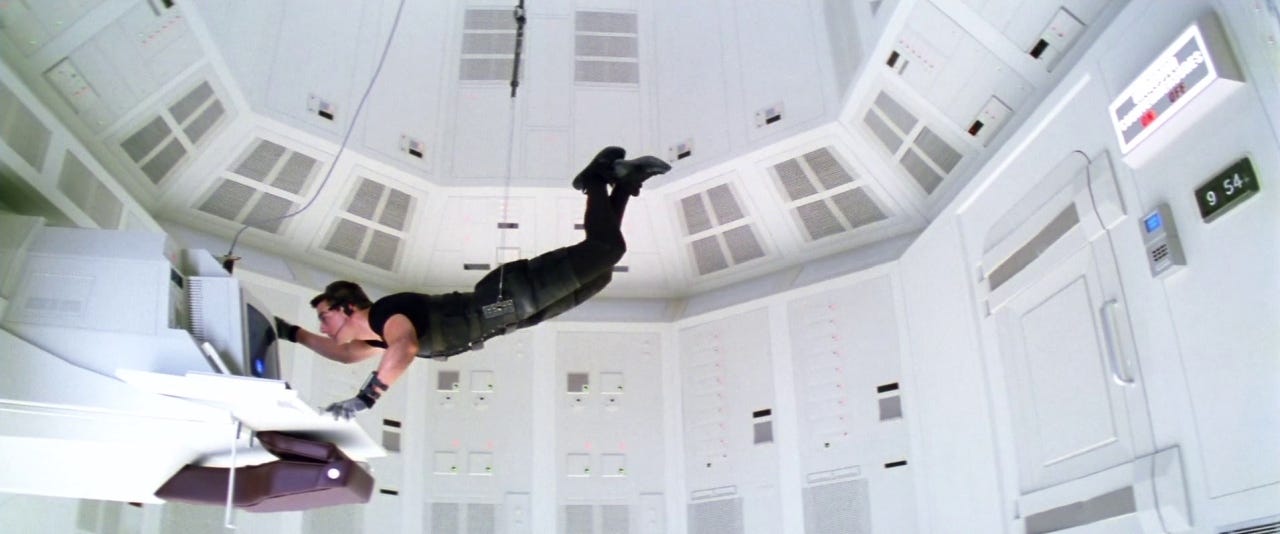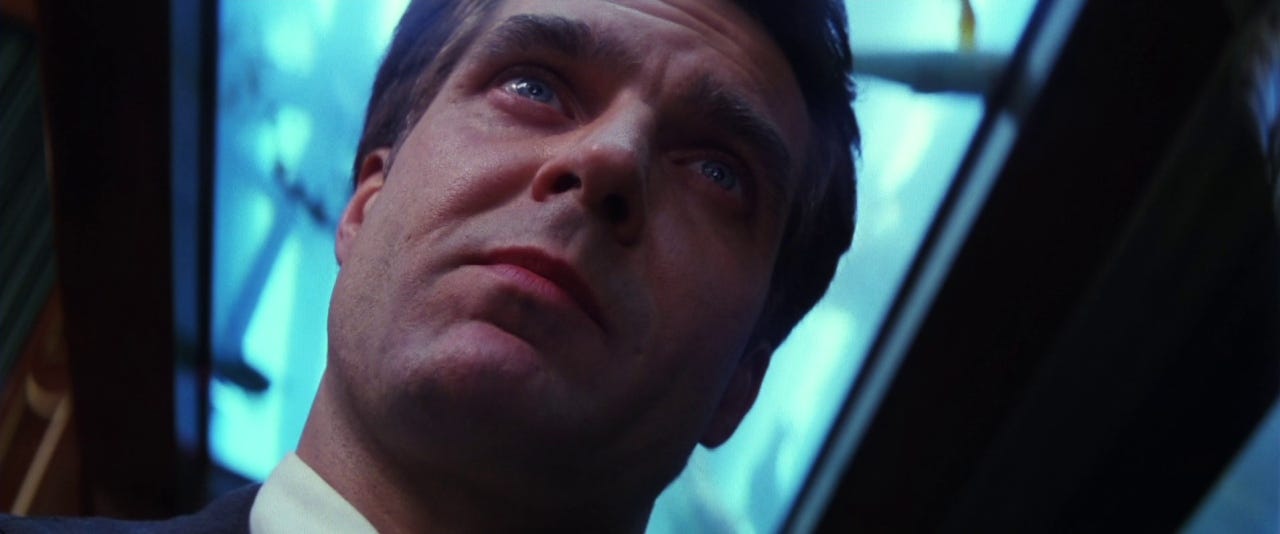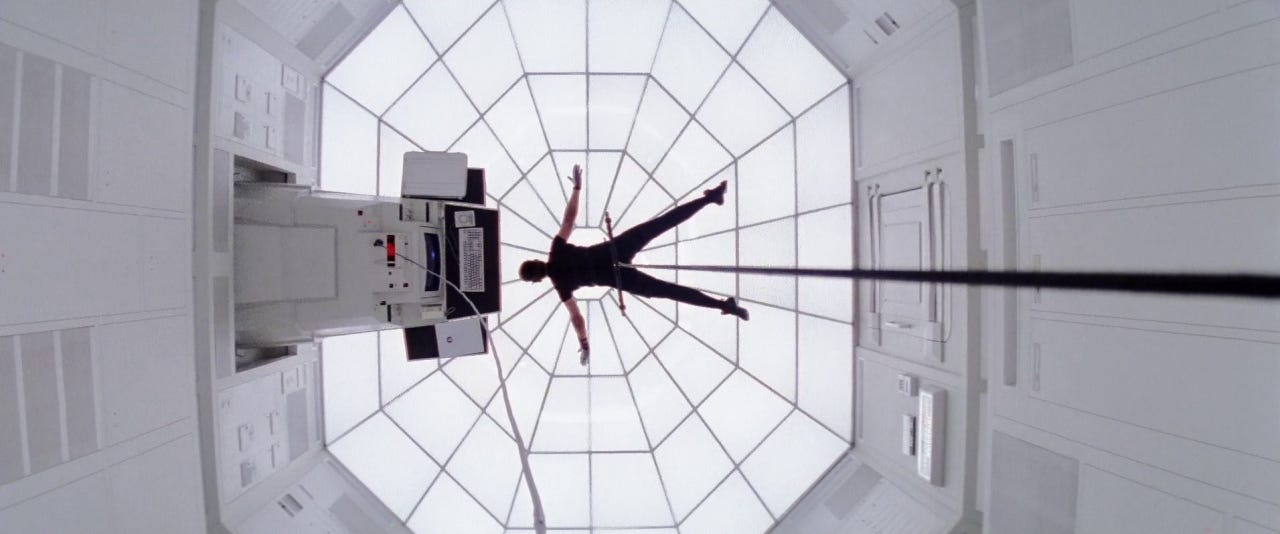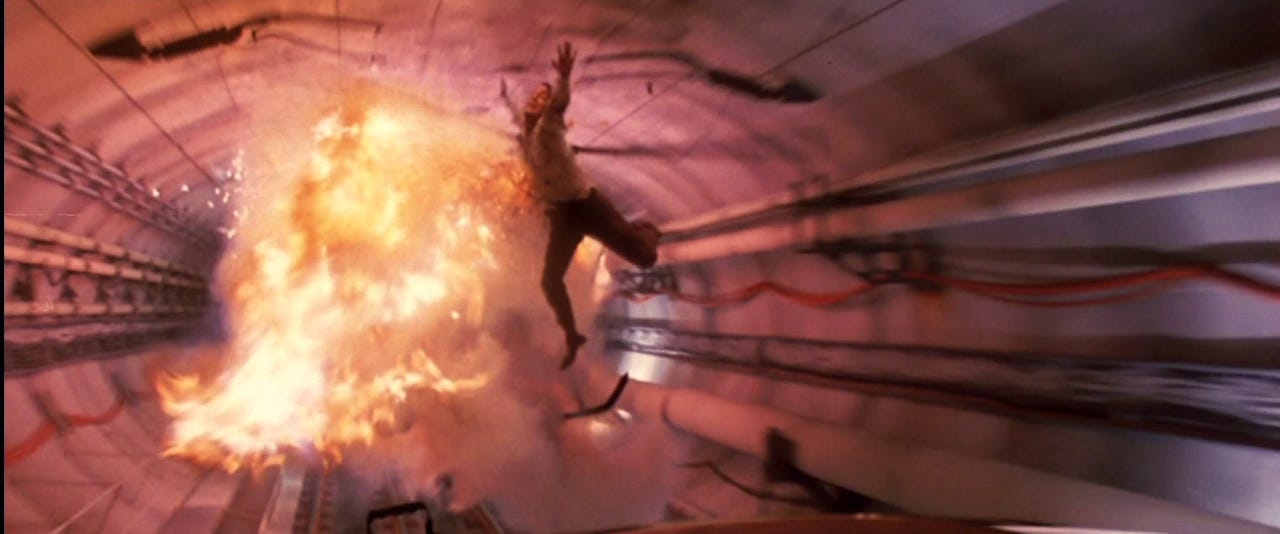Review: The original "MISSION: IMPOSSIBLE" is a stone-cold spy movie classic
Kicking off our 'Mission: Impossi-Week' retrospective
“You really think we can do this?”
“We’re going to do it.”
Mission: Impossible is my favorite film series to emerge in my lifetime, and at a whopping 29 years old now, it has been going for damn near all of that life. Tom Cruise first portrayed Ethan Hunt when I was three-and-a-half years old, and his journey as the character will seemingly culminate with The Final Reckoning next week, when I’m 32-and-a-half. The franchise has stretched across four decades, six US Presidencies, four Popes, and four live-action Batmans. When Mission: Impossible started, there had never been a Spider-Man movie; now, there have been ten, across four separate continuities. The entire Harry Potter series was written, adapted to film, and then began the process of getting re-adapted to TV while Mission: Impossible movies were coming out. This franchise has been running (figuratively and, in Cruise’s case, literally) for so long that its first home video release would have been on VHS; three subsequent physical media formats (DVD, Blu-ray, and UHD) have risen during its lifespan. When the original film premiered, the PlayStation was less than a year old in North America, and Nintendo’s flagship home console in the States was still the SNES – the N64 wouldn’t arrive on our shores for another few months.
There simply is no cinematic analogue for what Tom Cruise and company have achieved with this series, both in its longevity and in its ridiculously high standard of quality, with the series only getting better in the second half of its life. When the 007 franchise was 29 years old, there had already been sixteen movies and four separate James Bonds, and the franchise was on hiatus after going through several major identity crises and confronting the end of the Cold War. The most recent film, Licence to Kill, was an unabashed Miami Vice rip-off that climaxes with Timothy Dalton’s Bond dousing a drug lord in petrol and lighting him on fire. Meanwhile, Mission: Impossible has always had Cruise at its center, and it has only sharpened and refined its sense of tone, characterization, action, and visual storytelling as the years have gone on.
Revisiting the very first of these movies, Brian De Palma’s Mission: Impossible, is surreal: a film absolutely connected to an ongoing, active series, and yet one that also feels like stepping into a time machine. Cruise looks like an actual baby in this movie, and in one scene, while searching for info on a spy named Max, his first instinct is to type “Max dot com” into a computer and see what comes up. I’m pretty sure Ethan Hunt never once wields a gun as large as the mobile phones featured in this movie. This film is quite literally from another era: there is no way in hell such a relatively slow, cerebral thriller like this would ever get made as a major Hollywood tentpole today – even within this very franchise – let alone gross nearly half a billion dollars (just behind Twisters and Independence Day for the year) and be something of a sensation.
To be clear, none of that is a bad thing. The newer films, particularly once Christopher McQuarrie got involved, have more vivid characters and more bold, inventive action, but I really appreciate the slow-burn style of this first one. It has a somewhat thin script – or, at least, a script that prioritizes mood and movement over clearly comprehensible plot or deep character conflict – but the writing perfectly tees De Palma up to make a meal out of the material, and he threw his entire book of tricks at it: Dutch angles, reverse zooms, first-person POV shots, and performances that go from muted to melodramatic in mere minutes, etc. It’s expertly tense, but also wonderfully eccentric. A lot of it went over my head as a kid, when I first getting into this series around the time of the third film, but there’s good reason for that: This is a spy movie and popcorn flick for adults. It’s not necessarily ‘subtle’ – again, see the list of offbeat stylistic choices De Palma employs – but it’s very smart and methodical, and assumes the viewer is intelligent and patient too, inviting the audience to play along with the intricate spy mechanics and clues, to enjoy and get wrapped up in the tension, and to sometimes just enjoy the globetrotting vibes, which are consistently striking.
The famous sequence in the CIA headquarters where Ethan and company steal the NOC list is, hands down, one of the best set pieces in any spy movie ever, a masterclass of quiet, precisely constructed tension that blows me away every time I see it. The iconic image is Ethan suspended from the ceiling hacking the computer, but there are so many interlocking pieces at work here. And in a move that runs counter to Hollywood spectacle past, present, and future, the meat of the sequence starts with Tom Cruise turning to Jean Reno – but really to the audience – and insisting to him/us: “From here on in, absolute silence.”
The scene that follows lives by these words. Every sound effect is so carefully considered and doled out, because there are so precious few of them. The scene is so quiet and precise that it asks the viewer to be quiet with it, to the degree that one becomes extremely aware of the sounds of their viewing space, even of their own breathing. Every shot choice is so careful in what specific information it provides to the viewer, what exactly it wants us to be aware of at any given time to create maximum suspense (the tension of the rope, the temperature of the room, the movements of the office worker who stands to discover Ethan, etc.). The editing is so measured and precise in how it ratchets that tension up and down, very gradually, the length of shots slowing and quickening gently as the different planes of action interweave. The Mission: Impossible franchise has gone on to do many all-time great action set pieces, but they've never quite done a scene of pure sustained tension like this again. It’s the kind of scene anyone with any desire to make movies should do a deep, shot-by-shot dissection of, to understand how a film can expertly guide the viewer to the edge of their seat while making them feel like an active participant.
The grand finale with the bullet train, the helicopter, and the tunnel is another standout. It’s held back slightly by the dated early CGI effects, and if they did it today, Cruise would almost certainly insist on actually placing himself atop a speeding train, instead of settling for a sound stage. But on the level of conception, direction, cinematography, and editing, it all works so flawlessly that even today, knowing exactly what’s going to happen, I find it breathlessly exciting. CGI is just a tool; it cannot create the timing required to execute great action beats, but it is also unable to erase or submerge that timing if all the other fundamentals are executed at a high-enough level. The sequence makes it clear how many of the failures of today’s effects-driven spectacles are down not to the quality of the VFX, but to gaps in direction, to a dearth of imagination and preparation and understanding of the basic blocking and tackling of good visual storytelling. Good direction is magic: it knows no limits, and iffy CGI can’t hold it down. Mission: Impossible doesn’t just have good directing – at its best, it’s downright masterful.
There was definitely a period, over these last 29 years, where this first film seemed to be considered by many something of an odd duck, if not outright dismissed, a false start to a series that wouldn’t really get going for another decade. And there are probably still some fans of the later entries who have never gone back and given this one a fair shake (which is ironic considering how much Christopher McQuarrie seems to genuinely love this film, with how many times he’s nodded to it in Fallout and Dead Reckoning). But I love the movie to death, and I’m glad that cinephile culture seems to have come back around to recognizing how much this one slaps, even if it does so in a very different way than later entries in this crazy series. No franchise could have the longevity or greatness of Mission: Impossible if its foundational film were truly worth writing off; and so much of the DNA for what makes this series exceptional is readily apparent here at the outset.
TOMORROW: We continue our week-long retrospective with a look at by far the most divisive entry in the series, John Woo’s totally bonkers MISSION: IMPOSSIBLE II.
Read the book 200 Reviews by Jonathan R. Lack in Paperback or on Kindle
Subscribe to PURELY ACADEMIC, our monthly variety podcast about movies, video games, TV, and more
Like anime? Listen to the podcast I host with Sean Chapman, JAPANIMATION STATION, where we review all sorts of anime every week. Watch on YouTube or Subscribe wherever you get your podcasts.





